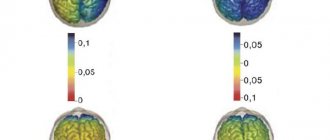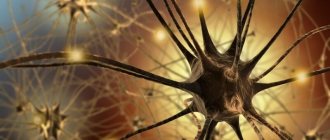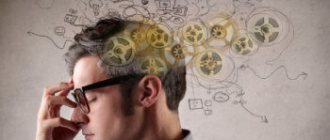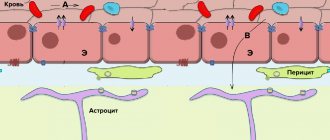And now with words.
In each test we check the dominant leg, arm, eye, side of the body. Each hemisphere controls the opposite side, therefore, if the right hand is dominant in a test, then in this test we consider the left hemisphere to be dominant, and vice versa. With the eyes, everything is more complicated, so in the seventh test, if the right eye reacted first, we note the dominance of the right hemisphere.
For the left hemisphere write the letter “L”, for the right - “P”, if in some test they are equivalent - o (zero).
- Interlocking fingers. Interlace your fingers as in the picture. Which thumb is on top? Label the opposite hemisphere as dominant.
- Rosenbach's test. Only 10% of people manage not to be stupid in this test. Take a pencil in your hand, hold it out in front of your eyes and aim at it. Close one eye, then the other. When closing which eye, the image shifts more (relative to the sight with both eyes)? Mark the opposite hemisphere as dominant in this test. If it moves the same or does not move, set it to zero.
- Napoleon pose. Cross your arms over your chest. Which hand rests on top of the other's forearm? Right - put "L", left - "P".
- Applause. Applaud with one hand on top. Which? Mark the opposite hemisphere.
- Cross your legs. Which leg is on top? The first reaction is important. Mark the opposite hemisphere.
- Wink. Which eye? If you are right, mark the right hemisphere; if you are left, mark the left.
- Get off your lazy ass and spin around on your own axis. Which way? Counterclockwise is left, clockwise is right.
- Now take an unlined piece of paper and a pen. Draw a vertical line dividing the sheet into two parts. Which part was larger? Mark the opposite hemisphere. Identical - put zero.
- Triangles and squares. Using each hand, draw three triangles and three squares on each side of the paper. Which ones are better? Mark the opposite hemisphere. Make a small allowance for untrained hands.
- Strokes. Here, too, for some reason everyone is stupid. With each hand, not counting, draw a series of vertical strokes (there is an example in the picture). Then you count the strokes. Which hand did you draw more? Mark the opposite hemisphere. If they are the same or approximately the same, mark zero.
- Using your normal hand, draw a circle and end the line with an arrow. If you drew it counterclockwise, oh, clockwise - “P”.
What does this or that result mean?
Warning. Everything that will be written next is taken from scientific and popular science literature (sources are listed at the end). But the brain is a very complex thing, so you don’t need to perceive everything as unambiguously as it is described.
If you have incomplete dominance of one hemisphere, then you can act as both a “left-brain dominant” person and a “right-brained” person (the terms are crude, but easier to write than “left-brain dominant people”, but since I am the author of the article, so I will write as it suits me). By the way, these are the majority.
The following describes the principles by which each hemisphere works; they are more pronounced in people who exhibit complete dominance of one of the hemispheres. Personally, I am very left-brain dominant, in case anyone is curious (I know, no one).
To begin with, here is a quote from a study using the electric shock method, in which only one hemisphere of the subjects remained “on” (for medical reasons):
A “left-hemisphere” person suffers from types of mental activity associated with imaginative thinking: he does not perceive the intonation composition of speech, melodies, is talkative, has a rich vocabulary, the types of mental activity that underlie abstract thinking are enhanced: there is a tendency to classification. Differs in a positive emotional tone. A “right-hemisphere” person demonstrates a sharp decrease in speech abilities, classification is impaired, is more readily explained by facial expressions and gestures, and is good at distinguishing changes in intonation. Differs in imaginative thinking. Negative emotions predominate.”(1)
And now a little more about what the quote says.
Test to determine the dominant hemisphere
All people, according to their thinking, are divided into right-hemisphere and left-hemisphere individuals, i.e.
In every person, one hemisphere is dominant. We present to your attention a fairly simple, but at the same time the most accurate test for determining the dominant hemisphere of the brain. 1. Interlace your fingers into a lock.
If the thumb of your left hand is on the top, write the letter “L” on a piece of paper, if the thumb of your right hand is the letter “P”.
2. Aim at an invisible target.
If you use your left eye for this, closing your right eye, write the letter “L”, if on the contrary - “P”.
3. Cross your arms over your chest in Napoleon pose.
If the left hand is on top, mark it with the letter “L”, if the right hand is on top, mark it with the letter “P”.
4. Applaud.
If you hit your right palm with your left palm, then this is the letter “L”; if your right palm is more active, it is the letter “P”.
Now evaluate the result using this scheme:
“PPPP” (100% right-handed) – orientation towards stereotypes, conservatism, non-conflict, no desire to quarrel and argue. “PPPL” – one of the most striking character traits is indecision. “PPLP” is a rather clearly manifested contact type of character. Coquetry, determination, sense of humor, artistry. (More often in women...) “PPLL” - this combination is not often found. The character is close to the previous one, only softer. “PLPP” is analytical, with at the same time softness. He gets used to it slowly, is careful in relationships, tolerance and some coldness. (More often in women...) “PLPL” is a very rare combination. Vulnerability, exposure to various influences. (More often in women...) “STI” – this combination is common. Emotionality, lack of tenacity and perseverance in solving important issues, susceptibility to other people's influences, good adaptability, easy contact, friendliness. “LPPL” is a more significant softness of character and naivety than in the previous case. “LLPP” – friendliness and simplicity, some dispersion of interests and a tendency to introspection. “LLPL” – gentleness, innocence, gullibility. “LLLP” – energy, emotionality, determination. “LLLL” (100% left-handed) – “anti-conservative character type.” The ability to look at the old in a new way. Strong emotions, pronounced individualism to the point of selfishness, stubbornness, sometimes reaching the point of isolation. “LPLP” is a very strong character type. But the inability to change your point of view. As well as perseverance in achieving goals and energy. “LPLL” is similar to the previous type, only not so unstable and prone to introspection. Experiences some difficulty in making friends. “PLLP” – easy-going character, ability to avoid conflicts, ease in making acquaintances and communication, frequent change of hobbies. “PLLL” – independence and inconstancy, the desire to do everything yourself.
If you get more “P” letters, then the left hemisphere dominates, and vice versa.
If the answers are equally divided, we offer you an additional test:
If the girl in the picture is rotating clockwise, then at the moment your left hemisphere of the brain is more active (logic, analysis). If it turns counterclockwise, then your right hemisphere is active (emotions and intuition).
Areas of specialization of the left and right hemispheres of the brain.
Left hemisphere:
Logical thinking
is the main area of specialization of the left hemisphere. The left hemisphere of the brain is responsible for language abilities. It controls speech, reading and writing abilities, remembers facts, names, dates and their spelling.
Analytical thinking:
The left hemisphere is responsible for logic and analysis. It is this that analyzes all the facts. Numbers and mathematical symbols are also recognized by the left hemisphere.
Literal understanding of words:
The left hemisphere can only understand the literal meaning of words.
Mathematical abilities:
Numbers and symbols are also recognized by the left hemisphere. Logical analytical approaches, which are necessary for solving mathematical problems, are also a product of the work of the left hemisphere.
Right Hemisphere
Intuition
is the main area of specialization of the right hemisphere.
Spatial orientation:
The right hemisphere is responsible for location perception and spatial orientation in general.
Musicality:
Musical abilities, as well as the ability to perceive music, depend on the right hemisphere.
Imagination:
The right hemisphere gives us the ability to dream and fantasize. With the help of the right hemisphere we can create different stories.
Artistic abilities:
The right hemisphere is responsible for visual arts abilities.
Emotions:
Although emotions are not a product of the functioning of the right hemisphere, it is more closely related to them than the left.
Mystic:
The right hemisphere is responsible for mysticism and religiosity.
Dreams:
The right hemisphere is also responsible for dreams.
Speech
The left hemisphere is verbal, it contains the center of speech, therefore left-hemisphere people are talkative. Ask me anything on a topic that interests me, and in a couple of minutes you will regret it. But at the same time, the right hemisphere is responsible for the emotional coloring of speech and intonation. In this vein, it is interesting to remember this. Owners of cats or dogs know that if you call your pet a bad word but affectionately, he will think that you are praising him. And why? Because there is no speech, but he picks up intonations. If the same is done to a person, he will be somewhat confused.
Verbal-nonverbal hemispheres are ambiguous. The left hemisphere is activated when reading scientific texts, and the right hemisphere is activated when reading literary texts. The right hemisphere is sensitive to humor and understands metaphors. (2) I am left-brained, so my metaphors are like oil spilled on the sea.
Find out how happy you are > >
Read the best materials from a happiness psychologist on this topic!
- Psychological test online. Psychological portrait of personality. Socionics Psychological test online from a happiness psychologist. Introduction to Socionics. Brief psychological portrait of 16 personality types. Determine your […]
- Personality test in pictures from a happiness psychologist. Another test picture from a happiness psychologist. This psychological test in pictures will help you determine your personality type. Select 1 of 9 […]
- Test Scheme| Inner Child |Test scheme “Character of the Inner Child” Test scheme for determining the character of the Inner Child from a happiness psychologist. In this online test, using a diagram, you will determine what character […]
- Monsters. Test picture Monsters and Demons. I suggest you take the new test picture “Monsters and Demons”. Choose a monster and let him show you what kind of demon you are currently in [...]
- Mentality test: psychogeometry of character and 4 figures of the psyche Mentality test - choose one of 4 figures and find out the properties of your character. The self-confidence test also offers 4 mental figures, [...]
- Test picture. Your online identity. Another psychological test using pictures will help you determine what kind of person you are on the Internet. An 8-picture personality test will show you how your […]
- Methods for solving problems in 3 words. We continue to study methods for solving problems. Today the method of solving the problem in 3 words. This technique is a kind of 3-word key to your problem. […]
Music
The left hemisphere does not perceive music; the right hemisphere is responsible for it. On the other hand, I came across information that the corpus callosum (it connects the hemispheres) is better developed in musicians than in people not involved in music. That is, musicians' hemispheres work more harmoniously. I found the same thing when I was doing research at university. Among music school students there were significantly more people with incomplete dominance of the right hemisphere than in the control group. In the control group, students with incomplete dominance of the left hemisphere predominated.
Workshop on determining the leading hemisphere.
Take a practical test consisting of 4 simple experiments to determine your own psychotype depending on the preferred type of action.
When taking the test, be guided by the picture.
The results of individual practical tests can be combined into a general formula, where P will mean the right hemisphere, L - the left.
What do you get as a result of the practical test?
Assign the correct letter to each of the 4 experiments and write in the same order as in the test.
Question No. 1.
Interlace your fingers and you will notice that the same finger is always on top, if the left one means you are an emotional person, the right one means you have a predominant analytical mindset.
Question No. 2.
Try to “aim” by choosing a target and looking at it through a kind of front sight - a pencil or pen. Try closing your eyes alternately. The leading eye is the one whose closure causes the picture to shift. The right dominant eye speaks of a firm, persistent, more aggressive character, the left - of a soft and compliant character.
Question No. 3.
If, when intertwining your hands on your chest, your left hand is at the top, then you are capable of coquetry, while your right hand is prone to simplicity and innocence.
Question No. 4.
When you applaud, one hand from above claps the other. If it is more convenient to clap with your right hand, you can talk about a decisive character; if you clap with your left hand, you often hesitate before making a decision.
Meditation
There are many different meditation techniques, but let's focus on the most seemingly simple one - sit in silence with your eyes closed, focusing on your breathing. Even such a seemingly simple exercise can cause a lot of obstacles. For the first time, it will be extremely difficult to sit for even a minute without annoying thoughts overwhelming your consciousness. However, by gradually stopping your stream of consciousness and returning to your breathing, you will help your brain reset. Daily practices help to get rid of anxiety, reduce the impact of stress and learn to control attention.
Research shows that those who practice meditation every day have a thicker layer of gray matter in precisely those areas that are responsible for attention and psychological flexibility. Training your brain through meditation means that over time you need to put less and less effort into focusing your attention. This means that over time it will become easier for you to concentrate in everyday life when it is necessary - for example, at an important meeting or taking an exam.
Exercise for the brain
Exercising your brain, like exercising your body, helps us stay young and energetic. When playing sports, muscle tissue is formed, the body becomes elastic and toned, approximately the same principle is observed when working with the brain: with regular exercise, new neural connections are formed, which affect psychological flexibility and the ability to adapt to different conditions. Moreover, as in the situation with the body, systematicity is an important condition for strong and sustainable health.
You can train your consciousness and brain in a variety of ways, for example, to improve concentration, puzzles, video games, various exercise equipment and speed reading are suitable. You can improve your memory and relieve stress through meditation and mindfulness practice. There are also methods that combine all this, based on the latest research in the field of neurophysiology, for example, neurofeedback training.
Online trainers and games
Crossword puzzles and printed Sudoku have been replaced by online services for brain development and training. You can choose anything from online puzzles to educational games that analyze your gaming behavior and adapt to your decisions. The most popular are Vikium, Uplift and Bitreynika. What is it for? First of all, doing exercises can just be fun. Secondly, it allows you to escape from everyday stressful situations with health benefits. From a pragmatic point of view, such exercises improve cognitive abilities, which over time will help you solve life and work problems faster, remember the names of colleagues and acquaintances, and remember important family dates.










